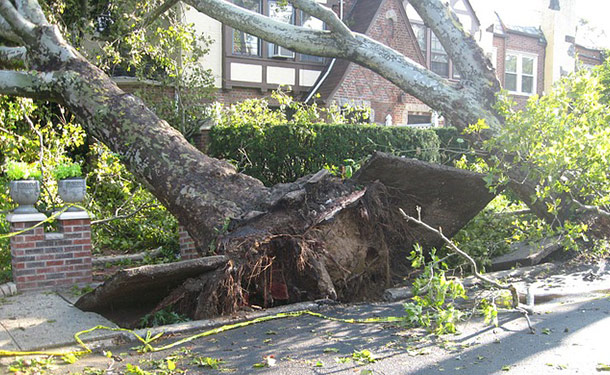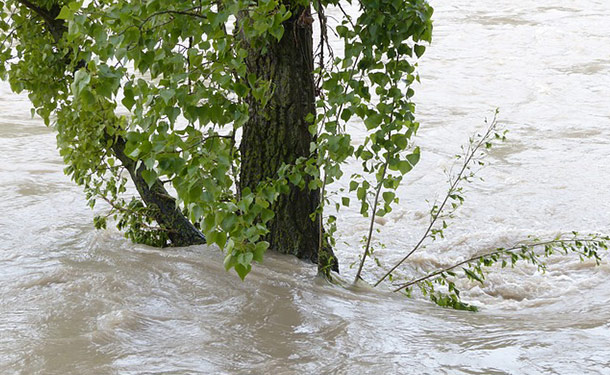Whether being from wind, snow, ice, either individually or in combination, blowdown (otherwise known as ‘windthrow’ and ‘windsnap’ being the breakage of the trunk instead of uprooting) is a real threat from trees that you may believe to be safe. Having your local tree professional survey the trees on your property is always a good move. As always, preventative measures save time, effort and money in the long run.

Trees In Urban Landscapes Suffer Greatly With Storms
Trees that grow or are planted too close to buildings or developed areas will not grow as they should. With one-sided roots or over-trimming by utility companies, these trees lack the necessary symmetry to prevent blowdown. Another factor in the urban area is sunlight. Without even sunlight, canopies will not grow evenly – causing further symmetrical disruption and ultimately leading to tree failure.
So, it is easy to understand why a seemingly light storm may actually wreak havoc in an urban setting – especially in the surroundings of recently developed areas. If you work or reside in such an area, bring out your Local Arborist to conduct a survey of the surrounding trees. AGAIN, prevention is key.
Tip – In urban areas look for uneven growth, sudden color change in parts of the canopy or leaning. These are all indications that something is wrong.
Shallow Root Systems Are Common
The bulk of nearly every tree’s root system will be found very close to the soil surface. Oxygen, moisture and nutrients are found there in abundance, so naturally, roots thrive there (typically 6 to 12 inches below the surface).
Few trees will grow tap roots (deep anchor roots). Depending on the environment, trees attempt to adapt. In dry arid climates, tap roots may develop in order to access deep underground aquifers.
Now combine a shallow root system with soaked soil from storming conditions, add gusting winds and the recipe for failing trees is at hand. Not to mention that a falling tree causes stress to its neighboring trees, which in turn may cause them to fall as well.

Tip – When you are able to see roots reaching across the soil, which were not visible before, erosion may be at play. It’s time for action.
Other Issues Floods and Storms Can Cause
Fungal Attacks – If you spot mushrooms growing on or near the base of a tree, this is a serious event. Mushrooms require decaying material to thrive and may signal that the tree is beyond salvation. Be on the lookout for small canker-like sores on twigs and branches, mushroom-like spores developing on recently pruned areas and “wet spots” which may appear anywhere on the tree. These are also forms of fungal infestations that must be quickly addressed.
Tip – Knowing how to identify some of the more common fungi will help in the extended health of your trees.
Root Rot – Fungal infections will also invade a tree’s root system. Without digging them up, there are ways to detect rotting roots. If you see mushrooms growing in the grass above the roots or areas in the soil or under the tree that seem mushy or hollow (as if the ground is losing support), it may be a signal that the roots are dying from a fungal infection.
Change or Loss of Beneficial Microorganisms – While the average homeowner is not a micobiologist (the study of fungi) nor microbiologist, from time to time, your local tree expert should be called upon to evaluate the soil surrounding a tree’s root system.
Insect Infestation – Easily detectable on the trunk, branches and stems, tiny (perfectly round or oblong) holes will be present. Frass (sawdust-like material) pushed out of the hole by the insect is sometimes present near the holes.
Tip – After a period of either drought or continuous rainfall and water shed, it may be prudent to call your Local Tree Professional to survey your trees for these and other potential issues.
Your Local Arborist Can Help Prevent Blowdown
I’m going to go out on a limb and say that a vast majority of incidents involving tree failure are implicitly due to a lack of preventative measures. Trees are living, adapting, growing members of the landscape and should be cared for. Contact your Local Arborist and take action while it is an option.